AMD Radeon HD 7750 & Radeon HD 7770 GHz Edition Review: Evading The Price/Performance Curve
by Ryan Smith & Ganesh T S on February 15, 2012 12:01 AM EST- Posted in
- GPUs
- AMD
- HTPC
- GCN
- Radeon HD 7000
Power, Temperature, & Noise
As always, we wrap up our look at a new video card with a look at the physical performance attributes: power consumption, temperatures, and noise.
While it’s the second sub-series of the 7000 series, the 7700 series is actually first in a number of ways for AMD. It’s the first midrange series to feature PowerTune since its introduction in 2010, and it’s the first time the 28nm process has been used on such low power cards. As such the power, temperature, and noise characteristics of the 7700 series are virtually a blank slate waiting to be filled.
| Radeon HD 7700 Series Voltages | ||||
| Ref 7750 Load | Ref 7770 Load | XFX R7770 BESDD | ||
| 1.1v | 1.2v | 1.2v | ||
The idle voltage for all 3 of our 7700 series cards was 0.825v. Meanwhile the load voltage for our 7750 was 1.1v, while it was 1.2v for both the reference 7770 and the XFX BESDD.
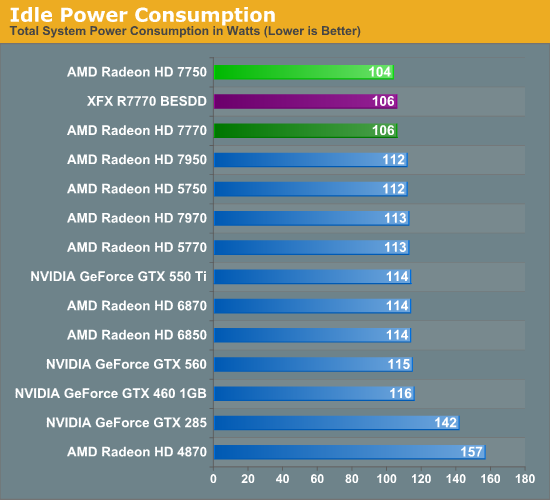
AMD’s official idle power consumption figure is <10W for both the 7750 and 7750. In practice we find that there’s a 2W difference between the two cards, with the 7750 coming in at 104W at the wall and the 7770 at 106W. AMD’s continuing efforts to reduce idle power consumption are clearly paying off, making this the lowest idle power usage figures we’ve recorded yet.
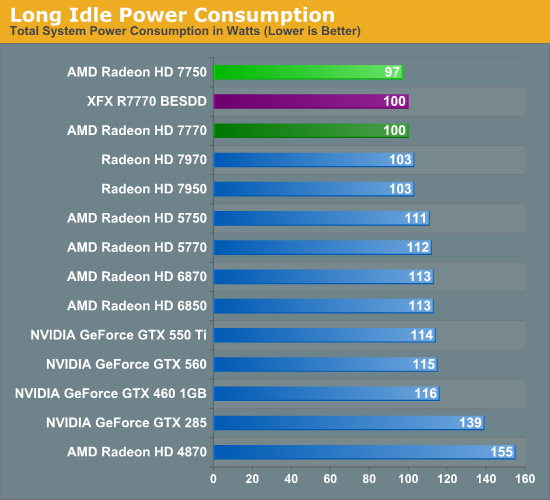
Meanwhile under the so-called “long idle” scenario with a blank monitor, the 7000 series continues to cement its lead. Officially all Southern Islands cards have a long idle power consumption level of <3W since they should all be using the same PCIe controller to keep a heartbeat going, however we’re finding there is a difference, even between the 7750 and 7770. The 7770 consumes 3W less than the 7900 series, meanwhile the 7750W consumes another 3W less, bringing it down to 97W. Since our readings are from the wall it’s tough to gage just how much these cards are still using, but at this point there doesn’t seem to be much farther to drop.
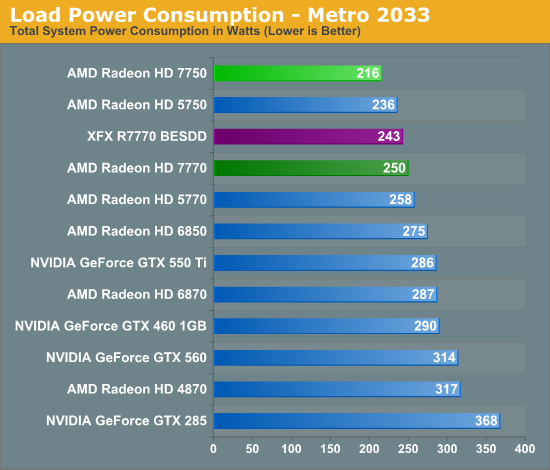
When we talk about the 7700 series bluring the line between what we’d expect out of an AMD 700 series card and an AMD 600 series card, results like this are part of the reason why. With a 75W PowerTune limit the 7750 has the lowest power consumption of any of the cards in our lineup, beating even the 5750. The 7750 is clearly in a league of its own, with only the 7770 drawing similar amounts of power as the 5700 series.
To that extent, it’s interesting to note that the XFX BESDD consumes less power than the reference 7770, in spite of its factory overclock. XFX did not increase the voltage of the card, but we’d still expect power consumption to go up at least a bit, not come down. In any case even with its 10% better performance, it’s consuming 7W less than the reference 7770 here. Otherwise at 250W the 7770 is pulling 8W less than the 5770 and 25W less than the 6850 from the wall, succinctly showcasing the power benefits of TSMC’s 28nm process.
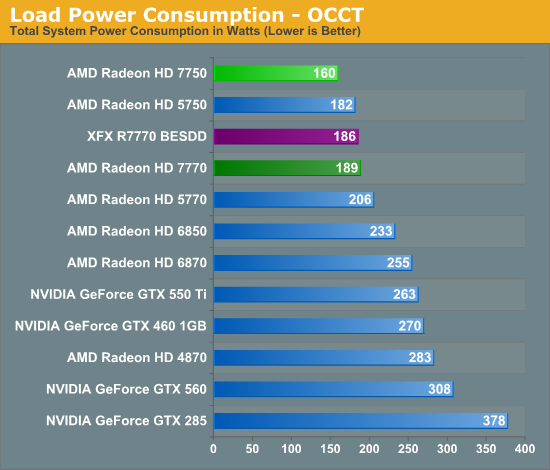
Our results with OCCT largely mirror Metro, with the 7750 in a class of its own while the 7770 consumes less power than anything other than the 5750. Since this is our pathological test, the lack of PowerTune plays a big part here, as PowerTune keeps the 7770 capped at 100W while the 5770 and 6850 are free to go well over their TDPs.
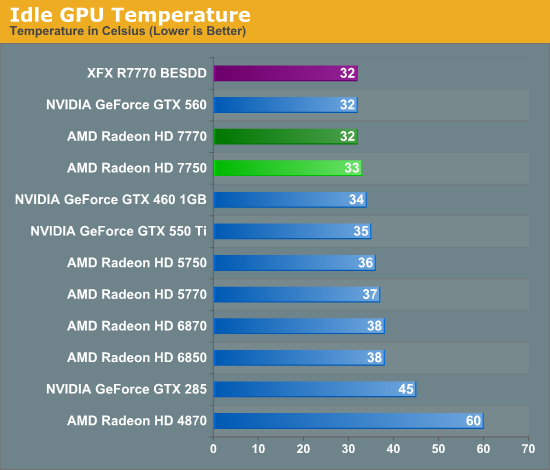
There’s little to say about idle temperatures that hasn’t been said before. With a half-decent cooler, almost any card can reach the mid-to-low 30s. The 7700 series is no exception.
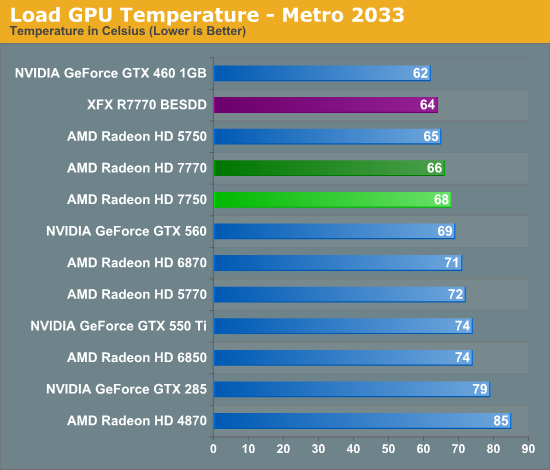
Moving on to Metro, our results are largely consistent with what we’d expect given our earlier power data. Even with the lower power consumption of the 7700 series AMD can’t quite beat the GTX 460 1GB, otherwise with temperatures in the mid to upper 60s the 7700 series looks quite good. XFX’s BESDD looks especially good thanks to the fact that it’s an open air cooler, as it only reaches 64C.

As with OCCT power consumption, OCCT temperatures are largely a story of PowerTune or the lack thereof. With PowerTune clamping down on power consumption, temperatures never rise by too much. At 71C the reference 7770 is still doing well, while XFX’s card does even better.
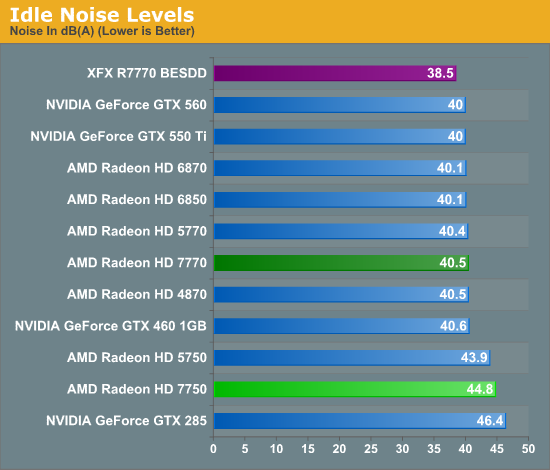
Based on our power and temperature data, our noise data came at somewhat of a disappointment. The 7750 has a small fan with an idle fanspeed of 39%, leading to it being quite loud relative to its competitors. Thankfully none of AMD’s partners will be using that specific cooler, so we wouldn’t expect any retail cards to be this bad. Though if silence is key, Sapphire’s passively cooled 7750 is always an option.
As for our 7770 cards there aren’t any surprises. The open air cooled XFX BESDD does the best, though at only 40.5dB the reference 7770 is doing almost as well on its own.
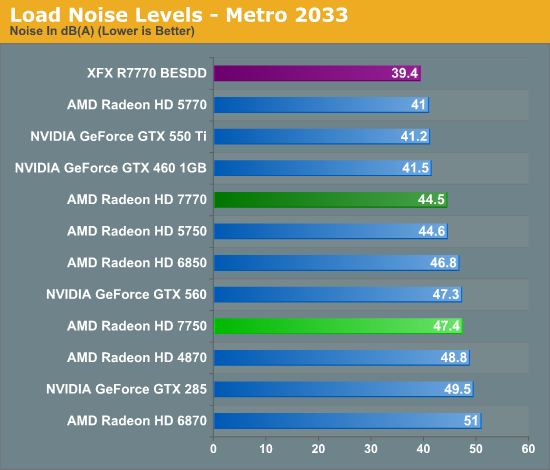
I had to rerun Metro a few times just to make sure our XFX BESDD numbers are right; and they were. XFX’s open air cooler combined with the 100W board limit of the 7770 means that there’s relatively little heat to dissipate, which the open air cooler does extremely well. While this isn’t technically silent it’s damn close.
Elsewhere the reference 7770 does decently, but its half blower nature hurts it when it comes to noise. The noisy 7750 only gets louder, unfortunately.
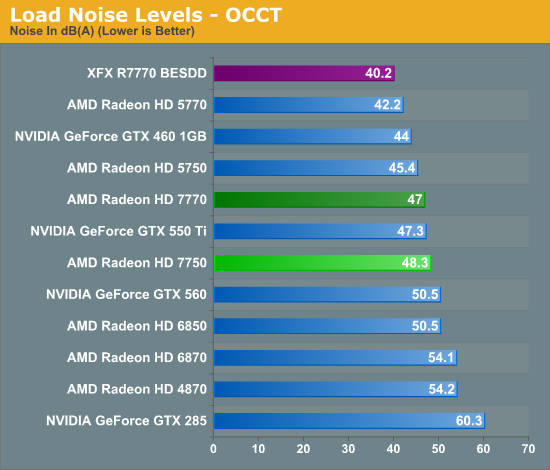
Finally, noise under OCCT is nearly the same story. The XFX BESDD finally goes above 40dB, a testament to the capabilities of XFX’s open air cooler. As for the AMD cards, there’s really not a great deal positive to say as even a traditional blower shouldn’t be quite as bad as what we’re seeing with the reference 7770. Perhaps it’s for the best that none of AMD’s partners are using their reference designs.










155 Comments
View All Comments
anactoraaron - Wednesday, February 15, 2012 - link
What happened there at 1920x1200 for the 6870? 23.2 fps seems a bit off to me. I get a solid 60 just about everywhere (occasional dips to ~50) at 1080.I am so glad I bought a 6870 ICEQ a month ago. Got the email today that I will be getting my rebate so your point about getting a 6870 for 159 AR is absolutely true. And the ICEQ edition I have is rocking a 1000/1150 oc all day long 32c idle 69c load via furmark 15 min run. Best part is it's much quieter than a reference card.
All of the 7xxx releases seem a bit lackluster to me.
Ryan Smith - Wednesday, February 15, 2012 - link
I go over this a bit in the commentary for that benchmark, but basically the 1GB cards are running out of memory in that benchmark. For reasons I've yet to determine, even though the 7700 series cards still only have 1GB they are handling the situation better than the 6800 and 5700.bazinga77 - Wednesday, February 15, 2012 - link
first thing that should be pointed out is that i believe that the 7700 series cards that launched today only have a 128 bit memory interface so no one should expect miracles especially at higher resolutions. the memory bandwidth on x700 cards and lower has always held them back a little, where as nvidia for instance on their 550ti uses a 192 bit memory interface. if this card used a higher bandwidth memory it would do better. also the 79xx series from amd upped the bandwidth from the 69xx series from 256 bit to 384 bit which is probably one of the reasons it was so impressive.well the gtx 460 is starting to disappear and amd discontinued the 6850 and 6870 two months ago so once they are gone they are gone. this is directly from amd. so i think this card fits in nicely and i expect once the 7850 launches that the price of this card will drop. i think that the 7770 almost being as fast as the 6850 isn't all that bad, especially because of how cool it runs and it seems like the factory oc cards close that gap even closer. considering how much power some of these cards took a couple of generations ago it seems like we are making progress. once the 7850 launches, which i believe happens next month, i think it will be the card to get, just as the 6850 was.
so all in all it seems like the 7770 will fit in nicely with a small price drop and and the discontinuation of some of the older amd and nvidia cards that has been happening, let alone taking into account the promotions we might see with rebates on these cards or bundled games etc.
lastly the 7750 seems like it will now be the best card on the market that doesn't require an external power connector and it will come in at only about $10 more than the current champ in that arena. so it looks like a nice card for the casual gamer or someone looking for an htpc card and it looks like the encoding features of the 77xx cards are pretty great.
chizow - Wednesday, February 15, 2012 - link
Like I said in the 7970 and 7950 review comments, the reality of the situation is only going to get worst as AMD reveals the rest of their 7-series product stack.Ryan I can tell you're doing your best not to be too hard on AMD but there comes a time we need to call a spade a spade. What AMD is doing here in terms of price and performance with the 7-series is easily the worst we've ever seen in the last decade from a new GPU architecture, especially considering they're also on a new process node.
If/when Nvidia pulls an RV770 on AMD, I really hope you and the rest of the media is up to the task the same way they were with the GTX 280. I don't think you were head GPU editor at that time but I'm sure you remember the backlash.
jjj - Wednesday, February 15, 2012 - link
So AMD either went stupid all of the sudden or they just can't produce enough cards yet and priced them to not sell.Either way,this is a mistake and they are only hurting their image (something they can't afford since Nvidia is still the stronger brand).Lets hope Nvidia wants market share and gives us something exciting soon.
stolid - Wednesday, February 15, 2012 - link
Arg. Might as well hang on to my 5770's. :/adonn78 - Wednesday, February 15, 2012 - link
And these cards are supossed to be an upgrade over the 6000 series how?Targon - Wednesday, February 15, 2012 - link
There is still a 7800 series set of cards that we have not seen yet. We saw the 7900 cards, and now the 7700 series. The comparisons here are 7700 vs. 6800 series, and that is ONE issue.Price vs. performance is the primary issue that I can see, and TIME will hopefully bring down the prices to a reasonable level. I also hope/expect that there are reasons for the prices that will be fixed quickly, so will reduce the prices. We shall see, but if NVIDIA is having problems, it may be that AMD is giving NVIDIA a chance to come back, and is saving their next big performance jump for that release.
chizow - Wednesday, February 15, 2012 - link
"Price vs. performance is the primary issue that I can see, and TIME will hopefully bring down the prices to a reasonable level."But that's exactly the problem, time hasn't brought price down to a reasonable level because we've already had 14+ months of this performance level at the same or better prices. AMD's pricing does nothing to shift the price performance metric and if anything, they are actually falling behind the curve a bit as you can get "old" parts that perform the same or better than these "new" ones at much lower prices.
The 7800 series will only emphasize this point further with similar performance relative to the 6900 series, but at much worst prices. But that's the trickle down effect of pricing a new "high-end" flagship part that's only 15-25% faster than the last-gen at a 10% price hike. There just isn't much value derived as you go further down the ladder.
ET - Wednesday, February 15, 2012 - link
This is disappointing, although I agree that the 7750 does have a place due to its low power. Let's see what NVIDIA will offer.The only ray of sunshine is that as always with a new architecture it takes a while for the drivers to take full advantage of the hardware, so it's possible to see performance improvements of tens of percents over time. Let's hope that's the case here.